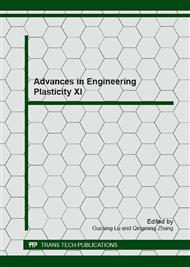p.101
p.105
p.109
p.113
p.117
p.121
p.125
p.129
p.133
Material Behaviors of PBX Simulant with Various Strain Rates
Abstract:
This paper is concerned with the material behaviors of PBX(Polymer Bonded eXplosive) simulant at various strain rates ranging from 0.0001/sec to 3150/sec. Material behaviors of PBX at the high strain rates are important in the prediction of deformation modes of PBX in a warhead which undergoes severe impact loading. Inert PBX stimulant which has analogous material behaviors with PBX was utilized for material tests due to safety issues. Uniaxial compressive tests at quasi-static and intermediate strain rates were conducted with cylindrical specimen using a dynamic materials testing machine, INSTRON 8801. Uniaxial compressive tests at high strain rates ranging from 1200/sec to 3150/sec were conducted using a split Hopkinson pressure bar. Deformation behaviors were investigated using captured images obtained from a high-speed camera. The strain hardening behaviors of PBX simulant were formulated by proposed strain rate-dependent strain hardening model.
Info:
Periodical:
Pages:
117-120
Citation:
Online since:
January 2013
Authors:
Keywords:
Price:
Сopyright:
© 2013 Trans Tech Publications Ltd. All Rights Reserved
Share:
Citation:


